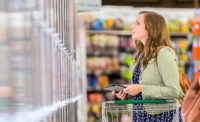Special Report | State of the Industry 2020
The state of packaging 2020: packaging trends

The market for meat packaging is expected to experience significant growth during the next five years, according to The Journey Ahead for the Meat Packaging Industry, a market study from Infiniti Research. Market drivers include increasing urbanization in developing countries, the need to maximize shelf life and technology advances to reduce costs and increase the efficiency of operations, storage and transportation.
Short-term and perhaps permanently, the global coronavirus pandemic has changed consumer behavior and attitudes. Research from Midan Marketing, a firm that tracks trends and provides other services to the meat industry, shows 70 percent of consumers are concerned about the COVID-19 pandemic. For many, this has extended food-safety considerations to packaging and spurred the adoption of case-ready products to reduce the amount of contact store personnel have with the product. This heightened emphasis on food safety could encourage the use of film with an antimicrobial coating. Applied during the print finishing process, one silver-based coating inhibits the growth of pathogens on the surface of the package with only a modest upcharge.
State of the Industry 2020
OverviewBeef (NCBA)
Beef (FQF)
Pork
Chicken
Turkey
Veal
Lamb
Seafood
Food Safety
Workforce
Sustainability
Packaging
Watch the 2020 State of the Industry Webinar
Register for free today!
Another pandemic-related shift in behavior is storing more meat in home freezers. Michael Uetz, principal at Midan Marketing, says, “Our research shows that consumers are still stockpiling and freezing meat.” The Midan Marketing COVID-19 research study from late July showed 55 percent of consumers plan to continue to freeze meat more often than normal in the upcoming months. As a result, he says, “Freezing instructions and packaging that doesn’t require consumers to portion product into other containers will be important.”
The pandemic also has increased the number of online meat shoppers. The Midan Marketing study showed the number of consumers ordering meat online is around 52 percent and growing about 2 percent per month. Uetz says, “Packaging plays a large role in the experience the online shoppers have with their protein products … The increase in online meat shopping will increase the need for more consistent weights and packaging that will protect the product in shipping.”
For producers and retailers, the global pandemic has caused major supply chain issues from raw materials to finished goods as well as manufacturing labor shortages. Once the packaging supply issues were solved, “there was a migration from smaller to larger pack sizes,” says Parker Hall, vice president of research and development at Perdue Farms. He says, “This change allowed for the ongoing production and distribution of much-needed product to customers and, ultimately, consumers. Going forward, a lot depends on how consumers continue to react while the pandemic is ongoing and what the new normal will be after (the pandemic ends). With an increase in direct-to-consumer sales primary and secondary packaging will evolve … In the short term, the larger sizes will prevail, but when a new normal materializes, convenience and sustainability in packaging will be key areas of focus.”
As 2021 approaches, convenience and sustainability remain the main drivers of the meat, poultry and seafood packaging market, which is valued at $10.7 billion, according to Meat, Poultry and Seafood Packaging, a March market study published by Freedonia. Market value is expected to expand, spurred in part by a compound annual growth rate for seafood packaging of about 5 percent through 2027, according to a February study from Transparency Market Research, Global Seafood Packaging Market.
Virtually all packaging formats will contribute to the market growth with particularly strong performances from modified atmosphere packaging and vacuum skin packaging. The latter is projected to expand at a compound annual growth rate of 7.9 percent through 2024, according to Freedonia in its July Vacuum Skin Packaging market study. Meat, poultry and seafood represent 81 percent of this market with cheese and other foods accounting for the remaining 19 percent. Hall attributes the growing popularity of vacuum skin packaging to its more compact footprint compared with foam trays, shelf appeal and potential to boost shelf life.
Maximizing convenience
Microwaveable prep, single-serving portions, retail-ready packaging and easy-open/reclose features continue to deliver convenience. With the COVID pandemic shifting demand away from foodservice, interest in e-commerce and related packaging has surged. Perdue Farms, for example, has begun offering some of its most popular brands for direct sale to consumers.
Quick meal prep is the goal of a microwaveable pouch for StarKist Creations Microwavables seasoned, wild-caught tuna with vegetables and hearty grains such as quinoa, barley and brown rice. Available from many grocery retailers as well as Amazon, the shelf-stable lineup is designed to Tear, Heat and Go!, according to its marketing, and sells for $1.99 to $2.49 per pouch. Four flavors, BOLD Tuna Spicy Rice and Beans, Tuna Tomato Basil, Tuna Latin Citrus and Tuna Thai Green Curry contain fewer than 200 calories per serving.
More sustainable products
Continued retailer and consumer demand for more sustainable products is prompting the development of recyclable, compostable and biodegradable packaging options. As polystyrene foam bans continue and many retailers demand an alternative to foam trays, the use of clear polyethylene terephthalate (PET) trays continues to increase. “Foam trays are recyclable (technically), however, most municipalities will not accept them. While there are recyclability issues with PET (labels and sheer volume), it is 100 percent recyclable,” Hall says.
The demand for a recyclable alternative to polystyrene foam trays has prompted Perdue and a key supplier to develop a clear PET tray for tray pack poultry. Hall says it “has quickly become the industry standard on the #3 footprint small tray and is expanding across all tray sizes.”
Recyclability was the goal behind the selection of a mono-material film for both the thermoformed bottom web and lidstock for packaging meat and sausage products from Hütthaler KG, a family-owned business founded in 1897 and based in Schwanenstadt, Austria. With functional properties equivalent to previous multi-material structures, the recyclable film significantly improves carbon dioxide balance, provides barrier properties to maximize shelf life, reduces raw material usage and runs on existing equipment with excellent sealability.
More easily recycled, mono-material film also has been introduced for ground meat packaged on flow-wrapping equipment.
Biodegradable and compostable packaging options are evolving but adoption is still in the early stages. “Cost, complexity and performance (in-plant and on-shelf) are the key issues to solve,” Hall says.
One early foray into biodegradable packaging is Perdue’s use of a natural, water-soluble insulating foam for the shippers used for its new direct-to-consumer offerings.
Another commercially available, renewable packaging option consists of a sealable paperboard/film tray, which runs on existing tray lines. The film liner permits hermetic sealing for maximum product shelf life yet separates easily so the paperboard can be recycled.
Other trends
Labeling will become more informative and interactive. “Consumers still want transparency in the products they purchase,” says Uetz. “QR codes will continue to grow in importance as they can be used to help tell the story of the farm or ranch where the animal was raised.”
In addition, he says, “Consumers have an increased awareness of immunity-generating ingredients and with meat proteins full of vitamins and minerals, we anticipate that information being highlighted on packaging labels. Also, as meat protein providers we have the advantage of a simple ingredient list versus alternative proteins. We should use that to our advantage and point out the single ingredient included in meat proteins.” NP
Looking for a reprint of this article?
From high-res PDFs to custom plaques, order your copy today!





